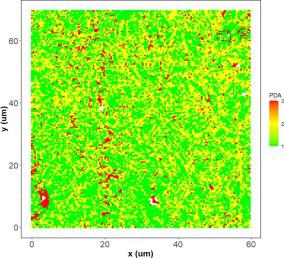当前位置:
X-MOL 学术
›
Mater. Des.
›
论文详情
Our official English website, www.x-mol.net, welcomes your feedback! (Note: you will need to create a separate account there.)
A novel machine learning method to exploit EBSD and nanoindentation for TRIP steels microstructures analysis
Materials & Design ( IF 8.4 ) Pub Date : 2024-02-23 , DOI: 10.1016/j.matdes.2024.112774 Federico Bruno , Georgios Konstantoupoulos , Gianluca Fiore , Edoardo Rossi , Marco Sebastiani , Costas Charitidis , Luca Belforte , Mauro Palumbo
Materials & Design ( IF 8.4 ) Pub Date : 2024-02-23 , DOI: 10.1016/j.matdes.2024.112774 Federico Bruno , Georgios Konstantoupoulos , Gianluca Fiore , Edoardo Rossi , Marco Sebastiani , Costas Charitidis , Luca Belforte , Mauro Palumbo

|
The recognition of phases and microstructures in TRIP-assisted bainitic-ferritic steels is challenging and requires sophisticated techniques to gain insights and reveal mechanical features with nanoscale precision. EBSD and nanoindentation have been employed to assess the surface composition and their properties within a reporting depth of 30 nm. Correlative mechanical microscopy and data science were used to overcome the shortcomings associated with the lack of an inclusive solution that combines the metadata from both techniques. A modular methodology is presented, which involves routines for exploiting structural and mechanical data via reproducible Machine Learning models (code and data are shared). The approach is structured to facilitate reuse by research community for correlating characterization mapping data, not limited to nanoindentation and EBSD. Gaussian mixture models are adopted to extract mechanical phases utilizing the nanomechanical properties. The K-means++ method is used for the first time to mine information from Inverse Polar Figure (IPF) mapping about anisotropy and to extract the knowledge from images for each grain, including grain coordinates and size. Moreover, k-nearest-neighbours regression was used to perform data imputation to fill in the values of descriptors related to missing coordinates relative to those of nanoindentation, grain boundary, EBSD phase, and EBSD anisotropy maps.
中文翻译:

一种利用 EBSD 和纳米压痕进行 TRIP 钢微观结构分析的新型机器学习方法
TRIP 辅助贝氏体-铁素体钢中相和微观结构的识别具有挑战性,需要复杂的技术来获得见解并以纳米级精度揭示机械特征。 EBSD 和纳米压痕已用于评估 30 nm 报告深度内的表面成分及其特性。相关机械显微镜和数据科学用于克服缺乏结合这两种技术的元数据的包容性解决方案所带来的缺点。提出了一种模块化方法,其中涉及通过可重现的机器学习模型(代码和数据共享)利用结构和机械数据的例程。该方法的结构旨在促进研究界重复使用以关联表征映射数据,而不仅限于纳米压痕和 EBSD。采用高斯混合模型利用纳米力学特性提取机械相。 K-means++方法首次用于从反极图(IPF)映射中挖掘有关各向异性的信息,并从图像中提取每个颗粒的知识,包括颗粒坐标和尺寸。此外,使用 k 最近邻回归进行数据插补,以填充与纳米压痕、晶界、EBSD 相和 EBSD 各向异性图相关的缺失坐标相关的描述符值。
更新日期:2024-02-23
中文翻译:

一种利用 EBSD 和纳米压痕进行 TRIP 钢微观结构分析的新型机器学习方法
TRIP 辅助贝氏体-铁素体钢中相和微观结构的识别具有挑战性,需要复杂的技术来获得见解并以纳米级精度揭示机械特征。 EBSD 和纳米压痕已用于评估 30 nm 报告深度内的表面成分及其特性。相关机械显微镜和数据科学用于克服缺乏结合这两种技术的元数据的包容性解决方案所带来的缺点。提出了一种模块化方法,其中涉及通过可重现的机器学习模型(代码和数据共享)利用结构和机械数据的例程。该方法的结构旨在促进研究界重复使用以关联表征映射数据,而不仅限于纳米压痕和 EBSD。采用高斯混合模型利用纳米力学特性提取机械相。 K-means++方法首次用于从反极图(IPF)映射中挖掘有关各向异性的信息,并从图像中提取每个颗粒的知识,包括颗粒坐标和尺寸。此外,使用 k 最近邻回归进行数据插补,以填充与纳米压痕、晶界、EBSD 相和 EBSD 各向异性图相关的缺失坐标相关的描述符值。



























 京公网安备 11010802027423号
京公网安备 11010802027423号